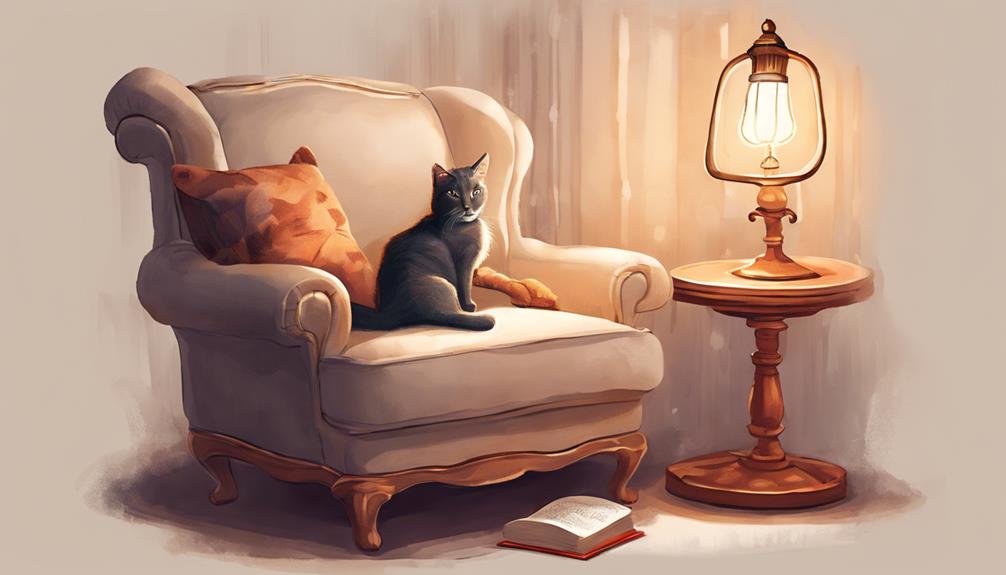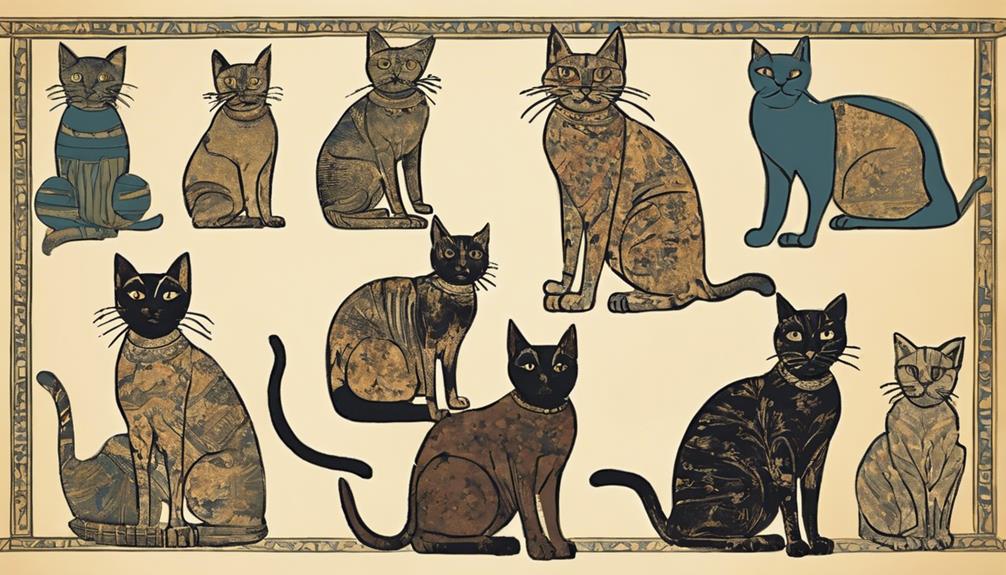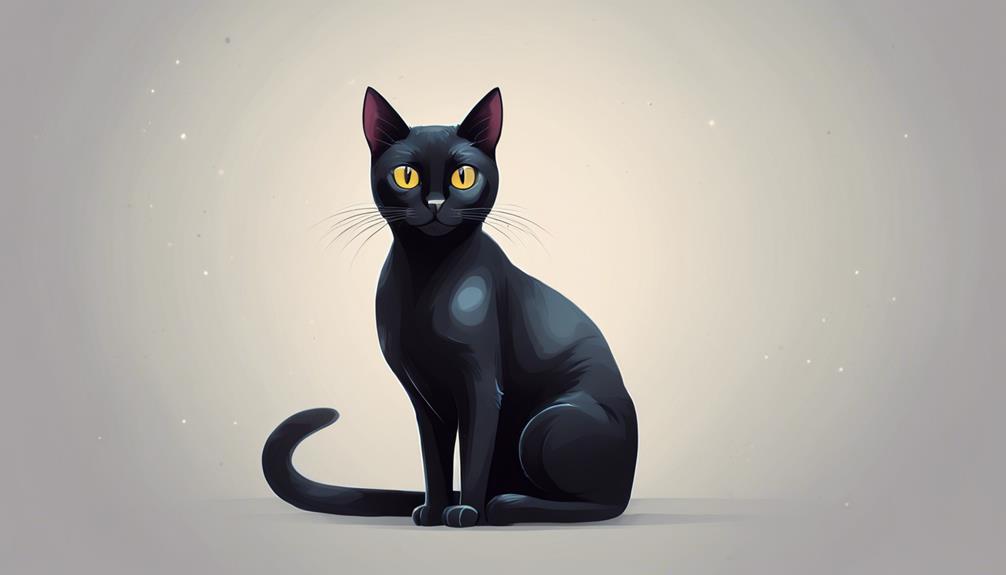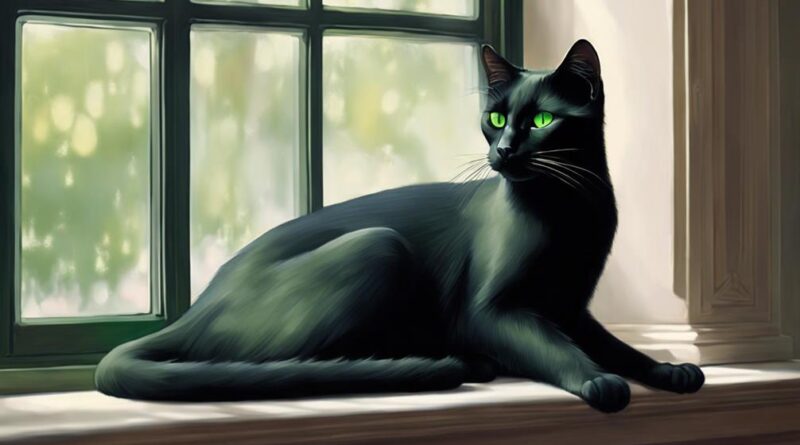11 Tips for Depicting Cats Artistically in Literature
To depict cats artistically in literature, start by choosing breeds that match your characters' traits. Capture feline mannerisms by detailing expressions and quirks. Show emotions through subtle cues like purring and prowling. Integrate cats into settings to enhance narratives – think cat cafes or urban streets. Use them symbolically to add depth and mystery. Develop unique cat characters with quirks for authenticity. Explore cat-human relationships to enrich plots and themes. Dive into cat psychology and behaviors to deepen storytelling. Incorporate cat dialogues and explore various time periods. Use cat imagery in metaphors while avoiding stereotypes. Unravel the secrets of cat portrayal in literature.
Choosing the Right Cat Breeds
When selecting the perfect cat breed for your artistic portrayal in literature, consider the unique characteristics and temperament of each breed to effectively convey your desired artistic vision. Cat personalities play a significant role in shaping the narrative of your story. For instance, if you desire a mysterious and aloof feline character, a Siamese cat might be the ideal choice due to their intelligent yet enigmatic nature. On the other hand, if you aim to depict a playful and energetic cat, a breed like the Abyssinian could bring that vivacity to your literary work.
Historical influences also play a crucial role in determining the cultural significance of certain cat breeds. For example, the Turkish Van breed has a rich history intertwined with Turkish folklore, making it a compelling choice if you want to infuse your story with elements of mystique and tradition. Understanding these historical connections can add depth and authenticity to your portrayal of feline characters, enriching the overall narrative.
When exploring feline characteristics, it's essential to delve into the unique physical attributes of each breed. The sleek and elegant appearance of a Russian Blue cat can enhance descriptions of grace and beauty in your writing, while the bold and striking markings of a Bengal cat can add a sense of exoticism and intrigue to your literary world. By carefully selecting a cat breed that aligns with your artistic vision and narrative goals, you can effectively bring your feline characters to life in a way that resonates with your readers.
Capturing Feline Mannerisms
To authentically portray feline characters in literature, capturing their unique mannerisms is key to creating vivid and engaging descriptions that resonate with readers. Feline expressions and body language play a crucial role in bringing these characters to life on the pages of your work. Cats are known for their wide array of facial expressions, from the slow blink of contentment to the sudden widening of eyes in surprise or fear. Describing these expressions in detail can help paint a more detailed picture of the emotions your feline characters are experiencing.
In addition to facial expressions, paying attention to cat habits and quirks can add depth to your descriptions. Cats have a variety of behaviors that are unique to their species, such as kneading with their paws when content, rubbing their face against objects to mark their territory, or arching their back in a defensive posture when feeling threatened. By incorporating these habits into your writing, you can create a more authentic portrayal of feline characters that readers will find relatable and engaging.
Conveying Cat Emotions Effectively
Effectively conveying cat emotions in literature requires a nuanced understanding of their behavior and body language to evoke genuine responses from readers. Cats are complex creatures that communicate their feelings through subtle cues. When expressing purring, a common sign of contentment, it's essential to describe the soft rumble vibrating through their chest, indicating comfort and happiness.
Prowling, on the other hand, signifies a mix of curiosity and readiness, with each silent step building tension and anticipation in the narrative.
Conveying whisker twitching can denote a cat's heightened sense of alertness or agitation. The delicate movements of their whiskers can reveal underlying emotions, such as nervousness or excitement. Meanwhile, tail flicking is a classic indicator of impatience or annoyance. Describing the rapid swishing of a cat's tail can effectively convey their growing frustration or irritation in a scene.
Integrating these subtle yet powerful cues into your writing allows readers to connect emotionally with the feline characters in your story. By paying attention to details like purring, prowling, whisker twitching, and tail flicking, you can create rich, dynamic portrayals of cat emotions that resonate authentically with your audience.
Integrating Cats Into Settings
Integrating cats into literary settings enhances the atmosphere and adds depth to the narrative through their mysterious presence and unpredictable behavior. When setting a scene in a cat cafe, the ambiance immediately becomes cozy and inviting. The soft purring, playful antics, and elegant movements of the cats create a soothing backdrop, perfect for heartwarming interactions or moments of introspection for your characters.
On the other hand, incorporating street cats into a setting can evoke a sense of rawness and vulnerability. Street cats, with their scrappy appearances and wary eyes, can symbolize resilience amidst adversity. Their presence in a rundown alley or a deserted urban landscape can add a layer of authenticity and grit to your story. Imagine a character finding solace in feeding these street cats, highlighting themes of compassion and finding beauty in unexpected places.
Utilizing Symbolism With Cats
Picturing cats within literary settings not only enriches the ambiance but also serves as a powerful tool for conveying deeper meanings through symbolism. Cats have been used as symbolic representations in literature for centuries, carrying allegorical meanings that add layers of complexity to the narrative. When a cat appears in a story, it can symbolize various concepts such as mystery, independence, or even danger.
In many works of literature, cats are portrayed as mysterious creatures, often associated with magic and the supernatural. Their enigmatic nature can symbolize the unknown, adding an element of intrigue to the story. Cats' nocturnal behavior and their ability to move silently also make them symbols of stealth and secrets.
Furthermore, cats are frequently depicted as independent animals, roaming freely and doing as they please. This independence can be a metaphor for rebellion against societal norms or a longing for freedom. By incorporating cats as symbols of autonomy, authors can explore themes of individuality and self-reliance in their works.
Additionally, cats can represent danger in literature, with their sharp claws and unpredictable behavior evoking feelings of unease. When a cat symbolizes danger, it can foreshadow impending threats or create a sense of tension within the narrative. By utilizing cats as symbols of peril, writers can instill a sense of foreboding in their readers, heightening suspense and drama in the story.
Developing Unique Cat Characters
When crafting unique cat characters in literature, consider delving into their individual quirks and behaviors to create captivating and memorable personas. Creating believable and relatable characters is essential in engaging your audience. To achieve this, start by exploring cat personalities to add depth and authenticity to your feline characters.
To develop a unique cat character, observe real-life cats or research their behaviors. Cats can be mysterious, playful, aloof, or affectionate, each with its distinct traits. Incorporating these characteristics into your cat character can make them more relatable and interesting to readers. For example, a cat that loves to chase shadows or a cat that hides in unexpected places can bring a sense of realism to your story.
Furthermore, consider giving your cat character a specific quirk or habit that sets them apart. Maybe they've a fascination with water, a particular dislike for a certain type of food, or a tendency to knock things off shelves. These idiosyncrasies can make your character more memorable and add a touch of humor or intrigue to your narrative.
Exploring Cat-Human Relationships

To understand the dynamics between cats and humans in literature, one must explore the intricacies of their relationships and the impact they've on storytelling. Cats have long been fascinating creatures, often depicted with a sense of mystery and independence that contrasts with the need for human connection in various narratives. This unique dynamic between cats and humans opens up a plethora of possibilities for exploring deeper themes in literature.
- Cat psychology: Understanding the behavior and instincts of cats can provide insight into their roles in storytelling and the way they interact with human characters.
- Human connection: The bond between cats and humans in literature can reflect themes of companionship, trust, and even conflict, mirroring real-life relationships.
- Cat symbolism: Cats are often used symbolically in literature to represent various concepts such as mystery, intuition, or even the supernatural, adding layers of meaning to the narrative.
- Literary interpretation: Analyzing the portrayal of cat-human relationships in literature allows for a deeper understanding of the themes and messages conveyed by the authors through these interactions.
Exploring cat-human relationships provides a rich tapestry for writers to delve into the complexities of human emotions and the enigmatic nature of feline companions, creating stories that resonate with readers on multiple levels.
Incorporating Cat Behaviors in Dialogue
How do cat behaviors enhance dialogue within literature, adding depth and nuance to character interactions and plot development? Understanding cat body language is crucial when incorporating feline communication into dialogue. Cats are known for their subtlety and nonverbal cues, which can be mirrored in literary exchanges to convey underlying emotions and motives.
Incorporating cat behaviors in dialogue can reveal much about a character's personality. For instance, a character who mimics a cat's grooming behavior during a conversation may convey a sense of self-assurance or even arrogance. On the other hand, a character who mirrors a cat's cautious movements might be signaling apprehension or wariness in a particular situation. These subtle cues add layers to dialogue, allowing readers to infer emotions beyond what's explicitly stated.
Moreover, exploring feline communication in dialogue can also drive plot development. A cat's sudden change in body language, such as arching its back or puffing up its fur, can create tension in a scene and foreshadow impending conflict. By integrating these behaviors into character interactions, authors can build suspense and intrigue, keeping readers engaged and eager to uncover how the plot will unfold based on these subtle hints.
Portraying Cats in Different Time Periods

Portraying cats across different time periods provides a unique lens through which to examine shifts in cultural attitudes and artistic representations. Cats have been a fascinating subject for artists and writers throughout history, adapting to the changing landscapes of human civilization.
- Cats in ancient civilizations: In ancient Egypt, cats were revered and considered sacred animals, often depicted in hieroglyphics and tombs. Their grace and mystery were intertwined with religious beliefs and daily life.
- Cats in Renaissance art: During the Renaissance, cats appeared in various artworks symbolizing different meanings. From representing domestic comfort to embodying sensuality and mystique in paintings, they played multifaceted roles.
- Cats in futuristic societies: Imagining cats in futuristic settings offers a glimpse into how society perceives these animals in advanced technological eras. Whether as robotic companions or evolved beings, cats in the future reflect our hopes and fears.
- Cats in post-apocalyptic worlds: In dystopian or post-apocalyptic narratives, cats often symbolize resilience amid chaos. Their survival instincts and independence make them intriguing characters in desolate landscapes, hinting at hope and endurance.
Exploring how cats are depicted across time periods not only showcases the evolving relationship between humans and felines but also highlights the enduring allure and enigma that cats embody in creative expressions.
Using Cat Imagery in Metaphors
Across different time periods, the depiction of cats in literature has served as a rich source of metaphorical imagery, adding layers of meaning and symbolism to creative works. Cats have been used in literature to establish symbolic connections and create vivid literary comparisons. These metaphors often draw on the unique characteristics of cats to convey deeper messages.
Cats are frequently associated with traits like independence, mystery, and agility, making them versatile symbols in literature. For example, a cat's ability to move silently and with grace might be compared to a character's stealth or cunning in a story, adding depth to their personality. This literary comparison can evoke a sense of intrigue or unpredictability in the narrative.
Moreover, the enigmatic nature of cats lends itself well to symbolic connections in literature. A cat's tendency to roam freely and explore its surroundings can symbolize a character's desire for freedom or adventure. By incorporating cat imagery into metaphors, writers can evoke feelings of liberation, curiosity, or even danger within their works.
Avoiding Common Cat Stereotypes

To present cats in literature with depth and originality, authors must strive to avoid falling into common cat stereotypes that may limit the creative potential of their works. Challenging stereotypes and showcasing the individuality of cats can lead to more engaging and authentic portrayals in literature.
- Avoid the 'Evil' Stereotype: Cats are often unfairly portrayed as sinister or malevolent creatures. Instead of relying on this stereotype, explore the complexity of feline personalities, showing that they can be loving, playful, and loyal companions.
- Steer Clear of the 'Lazy' Label: While cats do enjoy lounging around, they're also curious, agile, and intelligent animals. Highlight their adventurous nature and their ability to adapt to various situations.
- Reject the 'Independent' Stereotype: While cats are independent animals, they also form strong bonds with their human companions. Showcasing their affectionate and social side can provide a more realistic representation.
- Avoid Overemphasizing Mysteriousness: Cats are often depicted as enigmatic and mysterious creatures. While they do have an air of mystery, they're also expressive and communicative in their own ways. Explore their communication styles and emotional depth to portray a more nuanced image.
Frequently Asked Questions
Can Cats Be Depicted as Main Characters in a Novel?
You can definitely have cats as main characters in a novel. Exploring feline protagonists can add a unique perspective to your story. Writing cat-centric stories allows you to delve into their mysterious nature, agility, and independence.
How Can Cats Be Portrayed in a Sci-Fi/Fantasy Setting?
When delving into a sci-fi/fantasy setting, cats can take on intriguing roles as alien feline species or magical cat companions. These creatures can add a mystical element to the narrative, offering a unique perspective or possessing extraordinary abilities.
Is It Possible to Write From a Cat's Perspective?
Sure, you can definitely write from a cat's perspective.
Exploring feline consciousness involves diving into their sensory experiences and instincts.
Understanding cat behavior helps in portraying their thoughts and emotions authentically.
By observing cats closely and imagining the world through their eyes, you can capture their unique perspective in your writing.
This approach adds depth and richness to your storytelling, creating a more engaging and immersive experience for your readers.
What Are Unique Ways to Describe a Cat's Physical Appearance?
When describing a cat's physical appearance, focus on their colorful coat patterns that can resemble works of art.
Highlight the way they strike playful poses, showcasing their grace and agility.
Pay attention to the intricate details of their whiskers, which add to their charm and elegance.
Describe their mysterious eyes that seem to hold secrets and depths beyond comprehension.
How Can Cats Be Used Symbolically in a Non-Fiction Piece?
When using cats symbolically in non-fiction, you can tap into their rich cultural significance and emotional connections. Cats are often portrayed as symbols of independence, mystery, and intuition.
Conclusion
In conclusion, mastering the art of depicting cats in literature requires attention to detail, creativity, and a deep understanding of feline behavior.
By choosing the right cat breeds, capturing their mannerisms and emotions, integrating them into settings effectively, and avoiding common stereotypes, you can create realistic and engaging portrayals of our beloved feline companions.
Keep these tips in mind as you bring your literary cats to life on the page.
